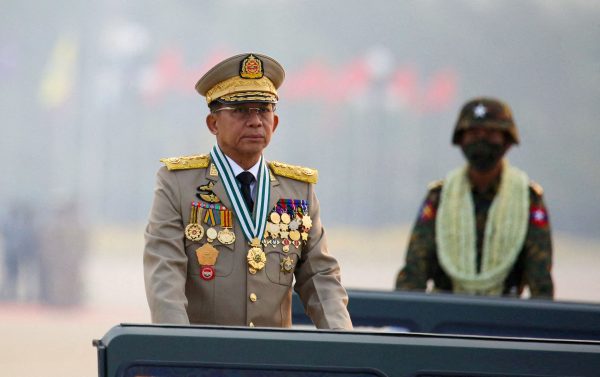In March 2021, China condemned the violence against civilians, halted investments and engaged with the exiled National League for Democracy (NLD)’s members. This support changed dramatically in 2023 as China began a new diplomatic approach. On 4 April 2023, the secretary of the Chinese Communist Party’s (CCP) Yunnan Provincial Committee Wang Ning arrived in Naypyidaw.
Later that month, an envoy from the CCP came and met former junta leader Than Shwe — now 90 years old — who had nurtured closer relations with China than Min Aung Hlaing. The envoy also met former president Thein Sein. These meetings were intended to ask the former leaders to advise Min Aung Hlaing, who is known to be anti-Chinese, to forge closer ties.
China’s strategy intertwines economic, political and military dimensions. Since the military coup, China has invested US$113 million in Myanmar.
The China–Myanmar Economic Corridor provides an important economic link between the two countries. The plan for a high-speed railway between Yunnan and Rakhine — which was shelved in 2014 — is now back on the table, as is a windmill project in Rakhine, a hydroelectric power station in Kachin state and a gas power plant.
For Myanmar, supplies of food, fertiliser and stable electricity are urgent, and China is addressing this through infrastructure. Since February 2023, the 770 kilometre-long Chinese-operated oil pipeline from Rakhine to Yunnan has been used to transport Russian oil to China. The pipeline begins at the deep-sea port in Kyaukphyu on Ramree Island and is very important to China’s Belt and Road Initiative.
On the political and military front, China worries about the border regions, where fighting between Myanmar’s military and ethnic armed organisations (EAOs) often land both bombs and refugees on the Chinese side. Qin visited the United Wa State Army, Kachin Independent Army, Arakan Army and other China-friendly northeast EAOs before he saw Min Aung Hlaing. Qin has urged Yunnan to strengthen its border defence.
China worries that the People’s Defense Force (PDF) will attack its investments in Myanmar. PDF attacked one of the stations on the pipeline in February 2022. In May 2023 a series of anti-Chinese protests arose — reflecting mounting resentment towards Chinese investments for neglecting the locals and the environment. The resistance has called for a boycott of Chinese products.
There has also been speculation that China is helping to construct a base on the 11 km-long Great Coco Island, which is located 300 kilometres away from Myanmar in the Bay of Bengal. The island has a radar station and an airfield.
Another sign of China’s offensive strategy in the region was a visit by Chinese diplomats to Bangladesh to accelerate the repatriation of Rohingya refugees, despite poor conditions in the Rakhine settlement camps.
The strategy in Myanmar is also part of China’s attempts to counter US influence in the region. The United States’ 2021 Burma Act will provide support to the National Unity Government and the resistance. This may have convinced China to support Min Aung Hlaing.
Chinese envoys have not been allowed to meet Aung San Suu Kyi and China is not happy with the NLD ban. Despite these concerns, a strategic triad alliance between China, Russia and Myanmar is emerging. Perhaps this is a convenient relationship for the three partners, but it is viewed cynically by Myanmar’s civilians.
Demonstrations have intensified and the pipeline has been attacked three times since Qin’s visit. The parallel National Unity Government has declared Chinese investments illegal. For Min Aung Hlaing, the alliance is a question of survival. He badly needs economic, political and military support and so has chosen to ignore resentment against increased Chinese influence.
Meanwhile, China’s Ambassador to Myanmar Chen Hai met with Myanmar’s Home Affairs Minister and urged him to crack down on the internet fraud and gambling hub Shwe Kokko run by Chinese criminals on the border with Thailand. The Ambassador urged Myanmar to rescue the people trafficked and trapped by Shwe Kokko. But their headquarters are guarded by the Border Guard Forces of the military, which have stakes in the business. China clearly wants Min Aung Hlaing to get control over matters affecting Chinese interests before it sends an invitation for an official visit to Beijing.
The military uses its Russian fighter aircraft and helicopters to bomb civilians, while troops have been burning villages and murdering civilians. The resistance is without a firm coherent command, needs more international help and depends on EAOs opposing the regime. But the resistance will not give up until there is substantial change.
Any mediation seems impossible and the generals are used to cope with international sanctions. China’s support of Min Aung Hlaing is bad for the resistance and the humanitarian crisis. If China’s support for Myanmar continues to be guided by a desire to serve its own interests, prospects for changing the situation will remain dim.
Mikael Gravers is Associate Professor Emeritus at the School of Culture and Society in the Department of Anthropology, Aarhus University.

